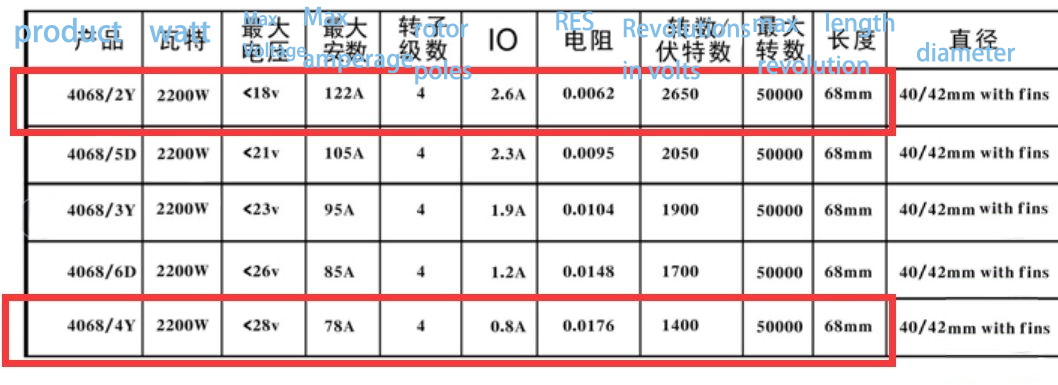We usually choose the motor for the car, 1/0 scale SCT motor size is 36xx, 1/5 and 1/6 scale motor size 5XXXX.
1/7 and 1/8 cars 4xxx (taking SVCT for example), for example, 3650, 36 represents the motor diameter and 50 represents the length. The difference between 3650 and 3660 is 10MM. What does that 10mm bring? At the same voltage and KV, this 10mm increase makes the car start harder and more violent and the difference is obvious, so why motor with 10mm longer become fiercer, the reason is the power.
You can think about the 2200KV at 2000KV and 3660 motor at 4274 kv, which one has more torque?
You must not hesitate to say 4274, because you know that 4274 motor is larger than 3660, large volume represents the large power, so torque may not decide by KV value, but by power. If KV determines torque, then why is 2000KV 3660 under 4S voltage less powerful than 2200kv 4274 motor, then you could say because they are not the same model, in fact, it is because of different power. (We generally do not compare motors across brands, because of workmanship differences, the actual power will be slightly different, so the default is to compare with the brand motor)
Therefore, it is concluded that the larger motor volume, the greater the power, the greater the torque. As you can see from the above example, power can be directly compared as the first measure of torque, but KV values are not directly comparable (except when the power is the same).
But can the same motor 1400KV (pictured) has the same power with a 4S as with a 6S battery? It takes 6S for 1400KV to reach 2200W. If only 4S is applied to 1400KV, what is the voltage (1320 watts)? At the same time, 2650KV also uses 4S (2053 watts). Do you think they have the same power? Is it different? So how do you compare KV?

Power determines the size of the motor we use. For example, if I want to use a 2400W motor for 1/8 MT, let's say I choose 3674. We almost don't think about power now, because we are used to using the model to distinguish the type of motor, but actually we are still choosing the power.
Then after the motor is determined, it is necessary to start to compare KV.
They say low KV with more torque, high KV means high speed.
For the above picture 2650KV and 1400KV motors, if they are put in the same car, which is faster?
Your first thought must be 2650KV. No!
Whether it's 2650KV or 1400KV, the speed is 5W, how can you say 2650 is faster? (Let's say that with no load, both cars turn the same speed at 5W. But the actual situation may be very complicated, 1400KV battery is heavier, but the voltage is high, more torque, may reach the speed closer to the limit speed, but it is only a tiny difference, this is very complicated let's not discuss.)
The 1400KV voltage was added to 28V to reach the maximum power, 10V higher than 2650KV, the high voltage shows that works more, and the power has not changed or 5W revolution, where did the more work go? It's going to be a torque force. Now 1400KV has more torque than 2650KV, its extra torque comes from the extra 10V voltage, this is the main reason, not because it is 1400KV. 1400KV is only the secondary reason, not the main factor affecting the torque, because only when the KV value is low enough can the voltage be added to achieve the same power as the high KV value. Under the same voltage (such as 18V), the speed of low KV is sacrificed. At this time, it does not get any benefits, but the speed is sacrificed and the power is reduced. However, by increasing the voltage (to 28V), the sacrificed speed is returned, i.e. the power is equal to the 2650kv of 18V, and the torque is greatly increased due to the increase in voltage.
So if the 1400KV motor does not have this 10V voltage, what is the torque advantage? With the same 18V, the 2650KV motor has reached the full power of 2200W, while the 1400KV motor has reached 64% of the total power (28V-10V = 18V is 64% of the original 28V) 1414W. Is it true that 64% power is stronger?1400KV at full power is strong because the voltage is high enough, but when the voltage is low to the same as 2650KV, where is the torque from, do the same work, the same voltage, less current, why you say it more strong? It should be the sacrifice rpm to gain more power, the low power is the main reason it reduces KV.
When the voltage is fixed, the motor with more power will have more torque and speed. When the power is fixed, the motor with lower KV will have more torque, speed and high KV equals.
When changing to turns, it means that when the voltage is fixed, the one who has the smaller Turns number will have the higher torque and speed. When the power is fixed, the motor with more turns will have more torque, the speed is equal to that of high KV.
Then a friend said, "The smaller your Turn number is, the greater the torque is and the faster the speed is. What's the point of high T number?"
When the voltage is constant, like I'm using 3S, a high T number really doesn't make sense, unless you want it to go a little bit slower. The high T number is for higher voltage, and the higher the voltage, the torque will increase, thus the heavier cars can be taken on more frequent stops and starts.
The level of T or the level of KV is in service of demand.
From above, we know how to compare the torque of the motor across levels. Under the same KV, the larger the motor, the greater the torque. But what if you want to choose different brand and different KV?
That's right, the power decides.


If you have a SCT, and only play 3S with the 3660 motor. In practice, how do I increase the torque if I only use 3S and all other settings remain the same?
- The voltage is unchanged. Increase the KV to obtain more power and thus improve the torque
- As shown below. If the same voltage, changing the higher motor with the same range KV value. Here the KV value must be strictly limited. If it is too low, even if the 3670 is replaced, the power is not as high as the 3660. That is to say, the 1900KV of 3670 under 3S is not as big as the 3300KV torque of 3660.
3660 at 3300KV for 3S is about 1000 watts
3670 at 1900KV for 3S is about 775 watts
Without changing the motor and all settings remains, it cannot increase the torque if not adding voltage only to reduce the KV value.
After reading these three figures, we all found that the same model and same motor same power. At this time, the lower the KV value, the higher the voltage, the greater the torque. And if the voltage is the same, you can no longer compare the KV value, at this time you need to compare power, the more power the greater torque.
Recommend below 1/8 YK4083 RC CRAWLER, please click the image for more detail information.



